Abstract
What if future teachers could learn to read the world like art historians, reason about it like mathematicians, and engage with it as sustainable change-makers? Through the lens of STEAM-H, this study examines their potential to become transformative educators fostering critical thinking and spatial–geometric competencies. The aim is to analyse how future teachers demonstrate Critical Spatial Literacy (CSL) skills—such as spatial literacy, critical thinking, and onto-semiotic dimensions—when carrying out hermeneutic readings of works of art and constructing models from AI-generated images within the framework of Critical–Visual Maker (CVM) Culture. This qualitative-descriptive study examines evidence from students’ analyses of pairs of classical and contemporary artworks, as well as models linked to the Sustainable Development Goals (SDGs), applying CSL categories in both cases. The findings reveal a transition from formal descriptions in mathematics and art history to more complex critical interpretations. Furthermore, the interrelationship among the three groups of categories proposed in the theoretical framework becomes evident. The study concludes that, by engaging in reflective and critical questioning, the interaction between STEAM-H, CSL, and CVM Culture can constitute an effective educational ecosystem for fostering geometric creativity, critical spatial literacy, and interdisciplinarity, thereby contributing to the development of a critical and egalitarian citizenship committed to global challenges and sustainable futures.
1. Introduction
In today’s sociocultural context, marked by the massive circulation of images in digital environments and the saturation of visual stimuli, developing a critical literacy around geometry as it appears in visual culture and art history is a fundamental educational priority. This is because such literacy fosters analytical thinking, aesthetic appreciation, interdisciplinary connections, and the ability to interpret and communicate in an increasingly visual world. In summary, it cultivates more observant, critical, and creative individuals who can understand the world through both aesthetic and logical perspectives. Indeed, images not only function as powerful vehicles for transmitting meanings, narratives, and sociocultural values but also shape individuals’ perceptions, thoughts, and actions, highlighting the need for a deeper visual–geometric understanding. This growing visual and cognitive complexity underscores one of the main challenges of 21st-century education: preparing citizens for a constantly changing world defined by globalisation, technology, social complexity, and sustainability. In addressing these challenges, the convergence of innovative approaches emerges as a key strategy for fostering meaningful learning. Among these approaches, the integration of the STEAM-H model (Science, Technology, Engineering, Arts, Mathematics, and Humanities), Critical Spatial Literacy (CSL), and the Critical–Visual Maker (CVM) Culture offers a pedagogical framework capable of responding to the demands of an interdisciplinary, multimodal, and socially engaged education. CSL combines spatial reasoning, semiotic analysis, and critical reflection to understand and analyse the geometric and sociocultural meanings of space and representation, which are further developed through CVM Culture, where creative making and visual–semiotic analysis enable the construction and transformation of social meanings through art and geometrical design.
The transversal nature of the STEAM-H approach transforms the teaching–learning process into an integrated project in which science, technology, engineering, arts, mathematics, and humanities collectively cultivate critical, logical, spatial, visual, and historical thinking, thereby enhancing mutual disciplinary understanding (; ; ). The dialogue between geometry and art history has generated a shared cultural heritage that fosters CSL, enabling students to interpret and reconfigure conceptual and narrative frameworks embedded in visual culture (). In this sense, the integration of scientific, artistic, and humanistic competencies within the STEAM-H framework makes it possible to articulate the rigour of mathematical geometry (; ) with the cultural, historical, and symbolic interpretation of visual forms provided by art history (; ). This articulation supports interdisciplinary learning processes grounded in critical and civic perspectives.
Accordingly, CSL broadens the educational scope toward a multimodal and critical literacy that integrates the visual, linguistic, auditory, gestural, and spatial dimensions (). This approach aims to equip students with the competencies needed to identify, analyse, and communicate visuo-spatial structures from both geometric and sociocultural perspectives, thereby strengthening not only spatial skills but also critical thinking capacities (; ; ; ). By incorporating tools such as Generative Artificial Intelligence (GAI) and frameworks like the onto-semiotic approach (), CSL becomes a bridge connecting mathematics education and social sciences education.
In parallel, CVM Culture adds a practical, experiential dimension to teaching, inspired by the Maker philosophy and by learning through the creation of physical or digital artefacts. This approach promotes experimentation, creative problem-solving, and collaborative work, linking abstract concepts—particularly those related to mathematics and geometry—with tangible experiences that foster deep understanding and the development of spatial and perceptual skills (; ). Furthermore, its capacity to integrate critical perspectives on sustainability and social responsibility enhances its relevance for shaping socially engaged citizenship.
The interaction among these three approaches, as represented in Figure 1, generates an educational ecosystem in which creativity, tangible practice, interdisciplinarity, and CSL reinforce one another, with each component driving the others forward. In this ecosystem, the STEAM-H model provides the interdisciplinary structure, CVM Culture introduces the practical and material dimension, and CSL offers the critical and multimodal component required to understand and transform the world from multiple perspectives. The outcome is a comprehensive pedagogical proposal that turns the teaching–learning process into a continuous cycle of creation, analysis, and application—one oriented not only toward competency development and meaningful learning but also toward the formation of critical and creative citizens for the 21st century.
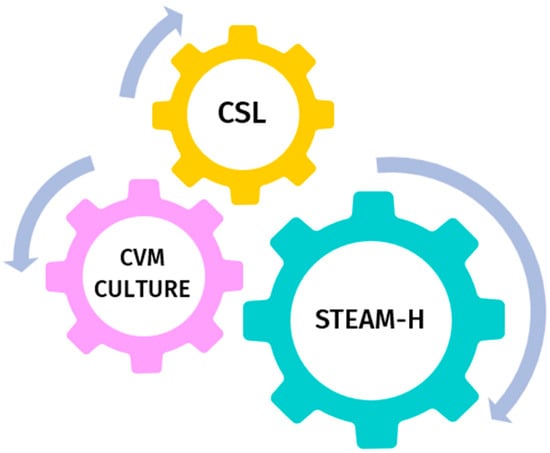
Figure 1.
Concept Map of the Project’s Teaching Approaches.
2. Literature Review
2.1. Understanding Geometric Visual Culture: STEAM-H as a Framework for Critical Spatial Literacy Facing the Challenges of the SDGs
Although various forms of literacy have emerged in recent years, several studies (; ) argue that it is more appropriate to speak of new dimensions or competencies within literacy. In this sense, the present study introduces CSL as an innovative dimension aimed at preparing students to identify, critically analyse, and communicate visuo-spatial structures from both geometric and sociocultural perspectives.
The development of CSL requires mastery of competencies related to two fields of knowledge: mathematics education and social sciences education. This is achieved by strengthening spatial skills—essential for spatial literacy—and critical thinking skills, which are fundamental for critical multimodal literacy. In this process, the onto-semiotic approach (), by integrating mathematical content with social contexts and meanings, serves as a bridge between the two areas of competence. To foster the acquisition of CSL, and thereby the development of skills for understanding geometric visual culture, the STEAM-H framework proves particularly suitable, as it integrates scientific, technological, mathematical, artistic, and humanistic perspectives (). This interdisciplinary approach enables learners to connect analytical and creative thinking, promoting a deeper understanding of the geometric structures, visual patterns, and cultural meanings embedded in visual culture. By engaging students in activities that merge reasoning, interpretation, and creation, STEAM-H provides the conditions necessary for developing both spatial awareness and critical reflection ().
The STEAM approach has proven highly effective in fostering student motivation, creativity, and self-efficacy, and it can be implemented from early education through higher education (; ). This approach transforms the teaching–learning process into an integrated, creative, and interdisciplinary project in which science, technology, engineering, arts, and mathematics are addressed in a transversal way, allowing for the development of scientific, logical, computational, and mathematical thinking (; ). Moreover, () and () argue that such projects enhance students’ cognitive engagement, provide meaningful learning experiences, and promote an understanding of the relationships among disciplines.
As an evolution of STEAM, the STEAM-H model is distinguished by its integrative perspective, which incorporates sustainability alongside humanitarian and artistic components, creativity, and social responsibility, making it a more comprehensive option better suited to the challenges of the 21st century (; ). The critical analysis of works of art, literary discourses, or historical narratives enables students to situate the Sustainable Development Goals (SDGs) within a historical trajectory and to recognise that present-day challenges are not isolated phenomena but part of long-term processes that require a conscious and engaged citizenry. Thus, the inclusion of the humanities within the STEAM-H framework reinforces the transformative potential of education, aligns with the 2030 Agenda, and fosters a critical understanding of the SDGs.
Art and geometry have maintained a symbiotic relationship throughout history: geometry has provided art with forms, methods, and systems of representation, while art has stimulated the development of different branches of geometry, such as projective geometry (). For this reason, this domain offers an ideal context for developing STEAM-H projects, as evidenced by various classroom experiences (; ). Given its close ties with art, geometry, and the study of spatial skills, the field constitutes an optimal setting for implementing such projects ().
Figure 2 provides a visual representation of how CVM Culture is situated at the core of the intersection among the six areas that compose the STEAM-H framework. Each coloured circle represents a discipline, while their overlaps highlight hybrid zones where knowledge domains interact. CVM Culture acts as a central space of confluence—a catalyst that integrates the visual, the tangible, and the critical, transforming knowledge production into a multimodal, collaborative, and creative problem-solving experience (; ).
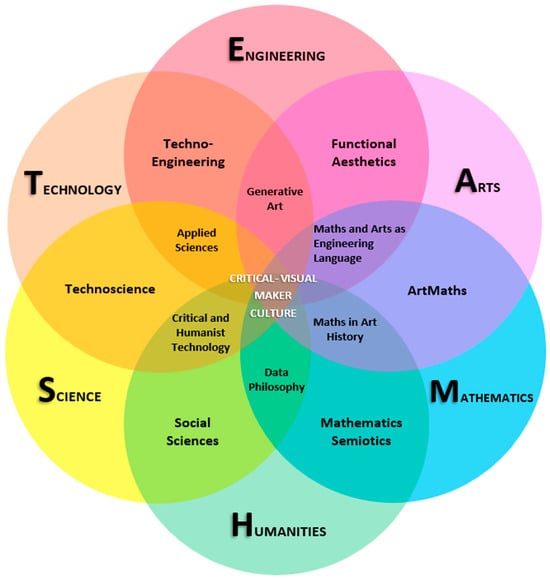
Figure 2.
Conceptual map of the STEAM-H educational model based on Critical–Visual Maker Culture.
At the upper end of the figure, Engineering connects with Arts to give rise to Functional Aesthetics, a domain in which aesthetics is not a mere ornament but an integrated function in the design of products, spaces, and experiences (). At the convergence of Engineering and Technology emerges Techno-Engineering, which combines engineering principles with technological innovation to address complex problems. At the same time, the intersection of Technology and Science gives rise to Technoscience, a synthesis in which technological advancement and scientific discovery mutually reinforce one another (). The convergence represented by Generative Art (at the intersection of Engineering, Arts, and Technology) exemplifies how artistic creation can incorporate algorithms, artificial intelligence, and computational processes to generate dynamic and adaptive works ().
In the zone between Arts and Mathematics, ArtMaths emerges as an interdisciplinary field that explores how mathematical principles inspire artistic creation and how art can facilitate the understanding of abstract concepts. The intersection of Arts, Mathematics, and Engineering produces Mathematics and Arts as Engineering Language, where mathematical language becomes a vehicle for artistic expression and engineering problem-solving (). The overlap of Mathematics with the Humanities gives rise to Mathematics Semiotics, which examines the meanings, symbols, and representations inherent to mathematical language, thus integrating cultural and philosophical dimensions into the discipline (). The intersection of Mathematics and the Arts, with a historical perspective, appears as Maths in Art History. This field investigates how mathematics has influenced proportions, symmetries, and geometric and visuo-spatial structures in artworks across history ().
At the lower central part of the diagram, the union of Humanities and Science gives rise to the Social Sciences, which are essential for understanding the social and cultural context in which innovations are applied (). The connection between Humanities and Technology gives rise to Critical and Humanist Technology, which examines the ethical, social, and philosophical implications of technology and explores how it can be directed toward the common good (). Near the centre of the diagram, beneath CVM Culture, appears Data Philosophy, an emerging discipline that reflects on the meaning, use, and ethics of data in a hyperconnected society ().
Figure 2 thus reflects not only a conceptual map of the possible connections within the STEAM-H model but also an operational framework for designing educational projects that unite theory, practice, and critical reflection within a single learning process.
The relationship between Figure 1 and the intersection diagram in Figure 2 lies in the fact that both represent different scales of the same pedagogical ecosystem. In Figure 1, the gears illustrate the functional dynamics among the three pillars—STEAM-H, Critical–Visual Maker Culture, and Critical Spatial Literacy—showing how each drives and reinforces the others. In turn, the intersection diagram in Figure 2 unfolds the internal structure of the STEAM-H approach, revealing how, at its core, CVM Culture articulates concrete connections among disciplines and hybrid fields such as ArtMaths, Mathematics Semiotics, or Critical and Humanist Technology.
The following sections explain the components that make up the STEAM-H framework, delving into their connections and specific features that enrich its educational application.
2.1.1. Spatial Skills (M for Mathematics)
For (), spatial—or visuo-spatial—skills comprise a set of seven abilities that enable the accurate perception of the visual–spatial relationships among objects. These skills are not merely innate capacities to be left to evolve spontaneously; instead, they can be trained through appropriate tools and methods ().
Through geometry, human beings have been able to perceive the forms in surrounding space through the senses, thereby allowing them to describe reality and transmit their perceptions (). According to (), teachers who correctly understand geometry can emphasise a creative dimension in their classes, since geometry can be considered as an introduction to mathematical practice. At the same time, such teachers focus instruction on the logical reasoning necessary to discover and classify spatial concepts, presenting this branch of mathematics as a helpful tool for modelling reality through practical examples ().
According to () and (), spatial visualisation can be conceived as the set of image types, processes, and abilities that enable students to generate, analyse, modify, and communicate visual information about real mathematical objects, models, and concepts. Geometry can also be seen as the starting point of visualisation within the mathematical context and constitutes an ideal field for strengthening both foundational knowledge and spatial skills (; ). In line with this, () already highlighted one of the main obstacles that students continue to face in classrooms today: representing geometric ideas in the presence of a highly complex visual vocabulary, rich with conventions and symbols that must be understood if learners are to make meaningful sense of them.
Research in mathematics education argues that greater emphasis should be placed on these skills within the curriculum (; ; ). Moreover, numerous studies have underscored that a lack of training and development of visuo-spatial abilities may be the root cause of many learning difficulties in mathematics education (; ). () demonstrate the need for a paradigm shift in both educational and methodological approaches to the development of these skills, with technology serving as a key support through interdisciplinary proposals framed within STEAM-H and oriented toward the development of critical thinking. () note that learning mathematics provides tools that advance other disciplines by fostering creativity and cultivating a type of reasoning capable of addressing unprecedented challenges with a critical problem-solving orientation.
2.1.2. Critical Thinking Skills (S for Social Science)
Critical thinking is a central axis of the STEAM-H approach, as this educational model not only integrates disciplines but also promotes reasoning, analysis, and evaluative processes that enable students to address complex problems from a reflective, situated perspective. According to (), critical skills include interpretation, analysis, inference, explanation, evaluation, and self-regulation—dimensions that have been recognised as essential to students’ comprehensive education. With a precise aim of contributing to democratic and civic formation, () emphasise that critical thinking entails questioning assumptions, broadening interpretive horizons, and cultivating the capacity for self-reflection—competencies that are enhanced in interdisciplinary contexts. In this regard, the transversality of STEAM fosters the development of such skills by articulating scientific and technical knowledge with humanistic and artistic dimensions, generating learning experiences with cultural and civic meaning (; ; ).
From the perspective of social sciences education, critical thinking takes shape in the epistemic practices of the historical discipline: analysing evidence, contextualising events, comparing narratives, and constructing reasoned explanations (). This approach has been extensively developed within the framework of historical thinking, which underscores the need to prepare citizens capable of using historical knowledge to understand and act in the present (; ; ; ). Research has shown that students develop critical thinking when they are exposed to historical sources such as cultural artefacts—including works of art—that they must question, contextualise, and evaluate, thereby constructing arguments that integrate both factual and interpretive dimensions (; ; ).
2.1.3. History of Art (H for Humanities and A for Arts)
The Visual Thinking Strategies, initially developed in the museum context, provide a dialogical methodology for reading works of art, activating cognitive skills such as observation and inference, and articulating individual perceptions, prior experiences, and cultural knowledge (; ). Critical visual literacy (; ; ; ; ) expands the interpretive dimension of the Visual Thinking method by situating images within frameworks of power relations, discourses of inequality, and sociohistorical contexts It equips learners with the analytical tools needed to connect observations with broader social, political, and cultural issues (; ; ).
In line with the ideas of () and (), the critical reading of art-historical works with strong geometric and historical content allows for the practice of interpreting symbolic meanings, analysing formal structures, inferring sociocultural relationships, and evaluating visual narratives (; ; ; ). In this sense, art history is not merely an illustrative resource but a catalyst for situated critical thinking, as it problematizes the connections between form, culture, and society ().
Moreover, the critical reading of artistic productions enables the deciphering of symbols or geometric structures. It prompts questions about how they reflect power relations, gender discourses, models of sustainability, or narratives of exclusion embedded in visual languages (; ). This fosters the development of a historical consciousness that connects past, present, and future, allowing for the recognition of continuities and ruptures in structural inequalities and for an understanding of how such tensions can be re-signified today to promote transformative reflection. Thus, exercises that move beyond mere aesthetic appreciation and position works of art as political texts in relation to universal issues aligned with the SDGs demonstrate that these goals are not merely institutional targets but historical challenges demanding critical and engaged citizens (). In this way, the analysis of art-historical works within the STEAM-H framework can become a laboratory for cultivating spatial and critical competencies oriented toward social justice and sustainability, in line with the transformative aims of education for sustainable development (ESD) (; ; ; ; ).
2.1.4. Generative Artificial Intelligence (T for Technology)
Technological transformation in society has led to the replacement of traditional software with intelligent programs such as Generative Artificial Intelligence (GAI) (). Although this technology originated several decades ago, it has only recently begun to be integrated into everyday life and studied across various disciplines, including education (; ). As () point out, there is now a wide range of AI tools characterised by user-friendly interfaces.
() highlight the importance of integrating digital and technological competence into teaching–learning processes. Teacher training in digital roles enables educators to use their professional knowledge to generate insights and act as critical, socially responsible, and committed agents (; ). To consolidate this teacher profile, it is essential to include the use of GAI tools in the development of digital competencies.
2.1.5. CVM Culture (E for Engineering)
Maker Culture is characterised by promoting active, collaborative, and interdisciplinary learning through the practical creation of physical or digital objects. Its educational application, known as Maker Education, fosters technical, cognitive, and social skills through direct experimentation and creative problem-solving (). () argue that when the practical relevance of mathematical modelling in everyday life is demonstrated within a didactic–methodological framework, it promotes meaningful and critical learning by associating it with concrete utility, thereby enhancing student motivation.
Within active methodologies and the “Maker philosophy” in mathematics education, modelling and constructing prototypes facilitate the projection of ideas to scale, producing objects that are easy for students to visualise and understand. As such, they become valuable didactic resources in the teaching–learning process of mathematics (). Geometry education, in particular, finds in Maker Culture a fertile ground for integrating abstract concepts with practical, tangible experiences. Through the direct manipulation of geometric objects—both physical and digital—students develop spatial abilities, visual perception, and a deep understanding of geometric relationships and properties ().
In terms of its implications for citizenship education, recent studies emphasise the importance of embedding sustainability and critical thinking within Maker Education, underscoring its potential to promote responsible practices and engagement with global challenges (; ).
3. Materials and Methods
3.1. Research Design
The research was framed as a case study with a qualitative and descriptive approach (). This study aimed to describe the relationship between STEAM-H, CSL, and CVM Culture. The research questions that guided the study are as follows:
- From the perspective of CSL, what spatial skills, critical thinking abilities, and dimensions of the onto-semiotic approach did students demonstrate in their geometric, visual, and critical analyses of works of art?
- How were these skills simultaneously evidenced and articulated within the process of analysing each work of art?
- In the training of future CVM teachers, what level of geometric–spatial skills and critical thinking did the student body demonstrate when modelling and constructing a prototype based on the generation of an AI-produced image?
- How could the interaction between the STEAM-H model, CVM Culture, and CSL generate an educational ecosystem that fostered critical spatial literacy, geometric visual creativity, and interdisciplinarity in pre-service teachers in the context of ESD?
3.2. Participants
The study was part of a broader research project carried out over two academic years within the courses Didactics of Geometry and Education for Citizenship and Human Rights, with a total of 106 participants enrolled in the third year of the Primary Education Degree at the University of Malaga (Spain). To ensure anonymity, each student was assigned a code from S001 to S106.
3.3. Design and Implementation
The research phases are detailed below.
- Phase 1. Acquisition of initial knowledge.Within the two courses, students were taught the foundational knowledge outlined in current educational legislation. These contents were necessary to equip students with the skills required to design curricular plans for both subjects.
- Phase 2. Practical workshop.The core of this phase was a collective, dialogical learning process involving both the teacher-researchers and the students, aimed at promoting reflective, collaborative interaction in which individual ideas and perspectives were valued within the parameters of Visual Thinking Strategies and critical visual literacy.To this end, during the initial development phase of the project, an extensive repository of 20 visuospatial cultural images (paintings, sculptures, photographs, installation artworks, etc.) was compiled, spanning from Prehistory to the present. The artworks were selected according to three main criteria: first, that they represented socially acute questions (SAQs, from the French questions socialement vives; ) corresponding to the Sustainable Development Goals (SDGs) of the 2030 Agenda, reflected in their historical representations and capable of being connected to current social contexts; second, that they enabled the analysis of spatial reasoning and the study of geometric interpretation skills; and third, that the social themes were visually articulated through geometric elements and compositional structures within the framework of CSL. This repository served as didactic material for CSL-based analysis and as the foundation for the subsequent generation of AI prompts.Based on this repository, students individually conducted a hermeneutical analysis of the images (; ), exploring key concepts, posing meaningful questions, and debating different perspectives according to the following fundamental premises:
- (a)
- Identify and highlight the geometric objects and properties present in the images.
- (b)
- Recognise the theme represented, situating it in its historical, social, and cultural context.
- (c)
- Construct meaning by interpreting the sociocultural content associated with the geometry identified in (a) and its possible connection to the SDGs.
- (d)
- Explore the potential didactic applications of the interdisciplinary connections identified in (c).
- (e)
- Critically reflect on the analyses carried out in the previous steps, as well as on the process of knowledge construction itself.
This study presents four works of art selected from the total analysed by students (Figure 3), as they were the most representative in relation to the objectives and analytical focus of this study: two from the pre-test phase (at the beginning of the study) and two from the post-test phase (after the completion of the main content blocks of the courses Didactics of Geometry and Education for Citizenship and Human Rights).
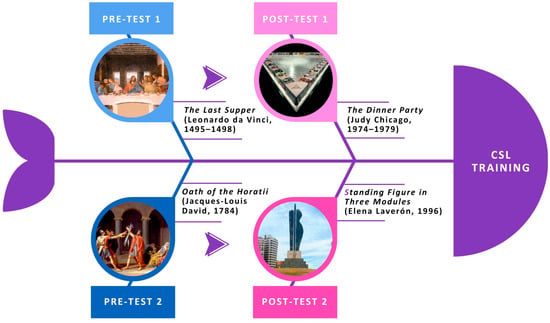
Figure 3.
Ishikawa diagram of the CSL training structure in Phase 2.
The selection of The Last Supper (Leonardo da Vinci, 1495–1498), The Dinner Party (Judy Chicago, 1974–1979), Oath of the Horatii (Jacques-Louis David, 1784), and Standing Figure in Three Modules (Elena Laverón, 1996) responded to the need to connect the teaching of geometry with critical reflection on historically and contemporarily relevant social issues, in alignment with the SDGs. These works constituted powerful didactic opportunities because they integrated geometric structures laden with meaning, whose interpretation transcended the formal dimension and opened the way toward the construction of critical and civic consciousness.
First, the dialogue between The Last Supper (pre-test) and The Dinner Party (post-test) (Figure 4) allowed for a contrast of two visual narratives linked to the social space of the meal. Through this pair of works, the following SDGs were addressed: SDG 1 (“No Poverty”), SDG 2 (“Zero Hunger”), SDG 5 (“Gender Equality”), SDG 10 (“Reduced Inequalities”), and SDG 9 (“Industry, Innovation and Infrastructure”). Leonardo’s work, with its striking geometric composition based on linear perspective and the centrality of Christ, exemplified the Renaissance ideal of order, hierarchy, and proportion. Its geometry reinforced the narrative of male authority and centrality within a specific religious and cultural context. In contrast, Judy Chicago’s installation subverted this tradition by introducing a triangular table (a geometric figure that evokes equality and balance) inscribed with the names of women marginalised by history. Here, geometry not only organised space but also served as a feminist and democratic manifesto.

Figure 4.
Geometric analysis of The Last Supper (pre-test) and The Dinner Party (post-test). Based on images of the artworks from Wikimedia Commons and the Brooklyn Museum, respectively.
The contrast between these two works encouraged students to critically question how spatial arrangements and geometric choices constructed and reinforced particular social, religious, and gender values.
On the other hand, the pairing of Oath of the Horatii (pre-test) and Standing Figure in Three Modules (post-test) (Figure 5) offered a similar opportunity, this time to address the following SDGs: SDG 5 (“Gender Equality”), SDG 10 (“Reduced Inequalities”), SDG 16 (“Peace, Justice and Strong Institutions”), and SDG 17 (“Partnerships for the Goals”).
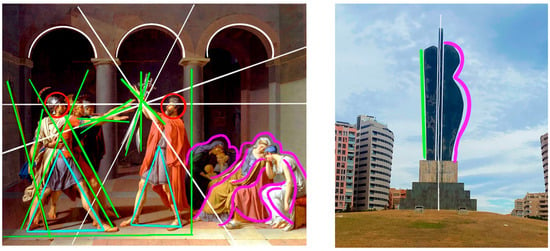
Figure 5.
Geometric analysis of Oath of the Horatii (pre-test) and Standing Figure in Three Modules (post-test). Based on an image of the painting from the Louvre Museum and on a photograph of the sculpture taken by the authors.
David’s painting presented a strongly geometric composition: straight lines, arches, and a clear division of space into thirds reinforced the Enlightenment ideal of rationality, discipline, and male patriotic duty, while positioning women in the subordinate role of passive spectators—confined to the domains of care, motherhood, and the household, and defined by emotion as opposed to male rationality.
Moreover, continuing these parameters of gendered geometric representation two centuries later, Elena Laverón’s modular sculpture employed articulated volumes to generate a monumental human figure. Located on a roundabout in front of the Faculty of Education Sciences of the University of Malaga, the sculpture offered students the unique opportunity not only to contemplate it in digital images, but also, before carrying out their analyses, to leave the classroom, visit the site, and explore its three-dimensionality by observing it from all possible viewpoints. Here, geometry performed a reductionist function, representing the human body through a binary conception of gender, in which the male figure was reduced to a straight line and the female to a curved one. This contrast enabled students to reflect on how geometric configurations were not neutral, but instead transmitted sociocultural values related to gender, power, equality, and citizenship.
- Phase 3. Prompt creation, generation of images with AI tools, and construction of models based on AI-generated images.
- In this phase, working in groups and building on the learning acquired during Phases 1 and 2, students used AI tools such as Leonardo.Ai (Image Generation V2) or ChatGPT (GPT-3.5) to generate an image related to one of the SDGs addressed during the practical workshop. Based on the selected SDG and their CSL, they designed an original prompt as complete as possible to provide the GAI with the key ideas they wanted reflected in the generated image. From the AI-produced image, they then constructed a physical model, applying all the knowledge acquired in the Didactics of Geometry course (scales, similarities, isometries, etc.) and in Education for Citizenship and Human Rights, focusing on their application to the SDGs.
- Phase 4. Analysis of evidence.
4. Data Analysis
The data were collected from individual student outputs in text format (artwork analyses) and from group outputs consisting of AI-generated images and models.
To ensure the reliability and precision of the qualitative analysis, the students’ analyses of the artworks were categorised using NVivo software. At the same time, co-occurrence networks were converted into Sankey diagrams using Visual Paradigm.
Sankey diagrams have emerged as valuable visual tools in qualitative educational research, given their ability to graphically represent transitions and connections between categories.
Categories for analysing CSL skills were defined based on theoretical references to Spatial Skills (SS) by (), Onto-Semiotic Approach Dimensions (OSAD) by (), and Critical Thinking Skills (CTS) by () and (). These categories are presented in Table 1 below.

Table 1.
CSL Categories.
5. Findings
5.1. CSL Analysis
The following section presents examples of verbatim excerpts from students’ analyses of each artwork, conducted from the perspective of their CSL. Specific fragments and keywords used for the categorisation of skill groups are highlighted with a colour code (Table 2).

Table 2.
Categorised excerpts from students’ analyses of artworks.
The diagram in Figure 6 shows the frequency of occurrence of each CSL skill in each artwork.
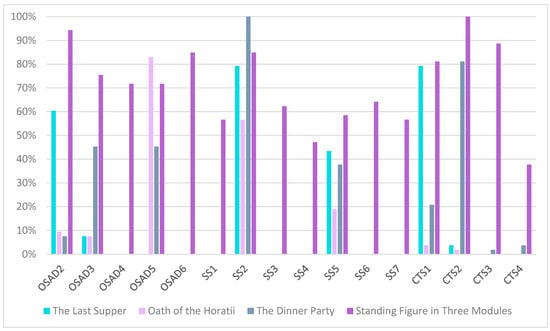
Figure 6.
Frequency of Categories in Pre- and Post-Test Analyses.
With respect to the analysis of the frequency of category occurrence in the pre-test artworks, The Last Supper showed high percentages in SS2 (79%), as recognisable geometric figures and concepts emerged, including geometric shapes, tessellations, symmetry, and the vanishing point. The categories OSAD2 (60%) and CTS1 (79%) showed high frequency rates, probably due to students’ prior knowledge of the work or, at least, of the religious theme it represented, culturally encoded in their collective imagination through cultural and religious experiences such as Holy Week. By contrast, Oath of the Horatii displayed a higher frequency in OSAD5 (83%). This could be explained by the fact that the painting, compared to The Last Supper, offered a greater diversity of iconographic elements, which students considered appropriate for exemplifying the geometric elements they identified. It also presented notable results in SS2 (56%), with recognisable elements such as straight lines, curves, semicircles, cylinders, and so on.
In contrast, in the post-test analysis, The Dinner Party showed more localised peaks, most notably in SS2 (100%), since both the composition of the work itself and all of its elements were geometric. SS5 (37%) appeared less frequently than in The Last Supper, perhaps because the post-test work contained fewer geometric concepts and objects. CTS2 registered a frequency of 81%, compared to OSAD2, which dropped to 7%. This could likely be explained by a more generalised association among students of the triangle as a symbol of female genital anatomy, rather than an understanding of it as an equilateral triangle representing equality. Furthermore, and in contrast to The Last Supper, two critical thinking categories emerged: CTS3 (2%) and CTS4 (4%). Although minimal, their presence indicated sensitivity to the feminist perspective of making forgotten female figures visible across all fields of knowledge.
Finally, Standing Figure in Three Modules showed high values across nearly all skill group categories, in several cases exceeding 80% and reaching 100% (CTS2). This was likely due to the sculpture’s conception, positioned halfway between the figurative and the abstract, which may have stimulated a richer interpretative engagement with its sociocultural meaning. Similarly, all critical thinking categories and onto-semiotic dimensions appeared, possibly as a result of the higher degree of CSL training acquired during the implementation of the proposal.
The following Sankey diagrams illustrate the co-occurrence among category groups for each artwork analysed. These were structured into three groups of categories, each corresponding to one column.
In Figure 7, which represents the flow of The Last Supper, the OSAD2 node was clearly the primary source of emission (with co-occurrences of 74.14% with SS2, 36.21% with SS5, 79.31% with CTS1, and 1.72% with CTS2). Its outflow volume greatly exceeded that of OSAD3. Most of OSAD2’s flow was directed toward SS2 and CTS1, suggesting a strong affinity or dependency between these two categories. SS2, in turn, channelled almost all of its flow directly to CTS1 (93.1% co-occurrence). In addition, OSAD2 also fed into SS5, albeit to a lesser extent. SS5 also directed most of its flow toward CTS1 (48.28% of co-occurrences), thereby consolidating CTS1 as the most relevant destination node in the diagram. CTS1 thus concentrated the majority of flows. All of this corroborated the earlier explanation of the students’ prior knowledge of the culturally encoded religious theme. On the other hand, OSAD3 participated with lower intensity. Its flow was distributed among SS2 (8.62%), CTS1 (8.62%), and SS5 (6.9%), which could be explained by students’ contextualization of social issues in the work through geometric relationships.
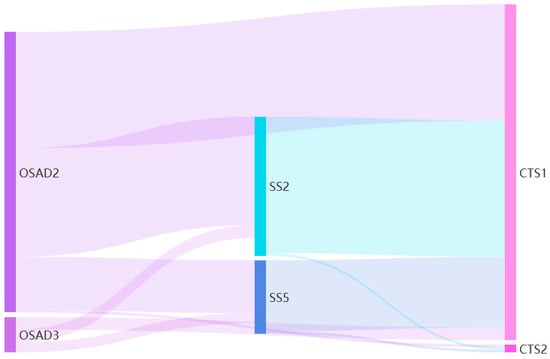
Figure 7.
Sankey Diagram of Students’ Analyses of The Last Supper.
Most co-occurrences were concentrated among OSAD2, SS2, and CTS1. There was, therefore, frequent interaction between geometric elements (SS) and their sociocultural meaning (OSAD), as well as between symbolic analysis and critical judgement or evaluation (CTS). This suggested an integrated reading of the work across different dimensions of vital and spatial thinking.
In Figure 8, which represented the flow of Oath of the Horatii, the OSAD5 node was clearly the main point of emission (with co-occurrences of 63.83% with SS2, suggesting a strong affinity or dependency between these two categories). OSAD5, in turn, channelled its flow directly to SS5 (23.4% co-occurrence). The flow of OSAD2 showed a greater relative dispersion, distributed between SS2 (4.26%) and SS5 (6.38%). All these relationships could be explained by students recognising geometric elements based on the visual aspects they identified in the artwork, which they then used to exemplify. Furthermore, part of the flow from OSAD2 and OSAD3 went directly to CTS1 (2.13%), as students recognised sociocultural meanings in geometric objects and, in some cases, provided social context.
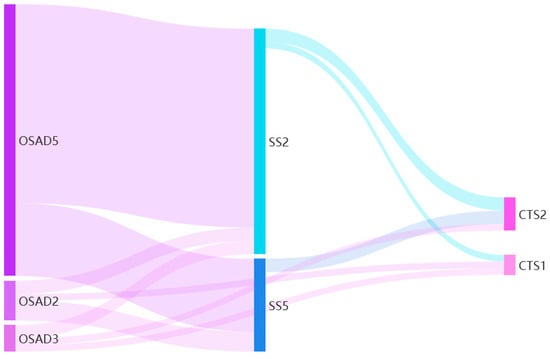
Figure 8.
Sankey Diagram of Students’ Analyses of Oath of the Horatii.
With respect to the Sankey diagram in Figure 9 for The Dinner Party, the data indicated that OSAD2 and OSAD5 presented the strongest connections toward SS2 (96.43%), followed by significant links to SS5 (76.79%). OSAD3 showed a co-occurrence of 41.07% toward SS2 and 35.71% toward SS5. This could be explained by the fact that geometric figures and their relationships with other geometric objects made it possible to establish links to the social context, fostering the recognition of these figures and their relationships, given the artwork’s fundamentally geometric visual structure.
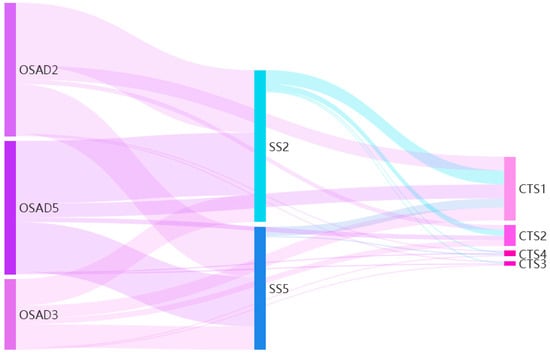
Figure 9.
Sankey Diagram of Students’ Analyses of The Dinner Party.
From the SS2 and SS5 category nodes toward the final CTS nodes, it was evident that most of the flows were directed toward CTS1, especially from SS2. A total of 21.43% of the connections from SS2 and SS5 converged on CTS1, whereas the percentages toward CTS2, CTS3, and CTS4 were lower, since CTS1 entailed a more basic interpretive reading of the work compared to CTS2.
In Figure 10, corresponding to Standing Figure in Three Modules, it could be observed that all nodes representing the three category groups were interconnected in roughly the same proportions. This suggested that the artwork exhibited a transversal representation across most of the categories analysed, which could be interpreted as greater versatility or breadth in its conceptual association among the different category groups.
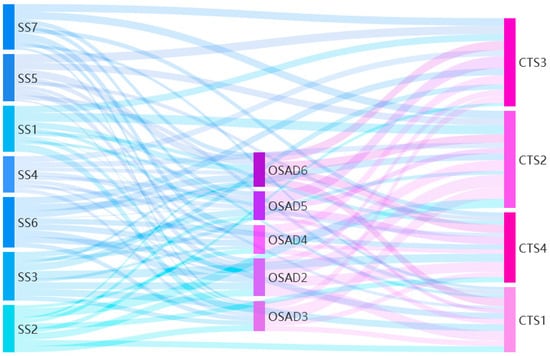
Figure 10.
Sankey Diagram of Students’ Analyses of Standing Figure in Three Modules.
5.2. CVM Culture Analysis
The students collectively produced 10 models related to specific SDGs, as detailed in Table 3.

Table 3.
Title and SDG of the models created by student groups.
As shown in Table 3, there were few models related to social or gender-related SDGs, despite their being addressed in the previous workshop. This may have been because it was more challenging to develop a mathematical model for these types of SDGs, as they involved more abstract, less tangible ideas.
The following section presents the analysis carried out to determine the degree of application of spatial skills and geometric concepts, as well as critical thinking skills, and the extent to which students adapted the AI-generated image to the physical model they constructed.
The use of visual schemes, such as the traffic-light analysis, has gained traction in educational research due to their capacity to synthesise and communicate findings clearly, making them versatile tools for representing levels of adequacy. This methodology, which classifies observations into high (green), partial (yellow), or low (red) compliance categories, allows identification of achievement levels. () demonstrated its effectiveness in the rapid categorisation of results through a chromatic system that facilitates interpretation, while () provided evidence of its validity for structuring data and generating comprehensible diagnostics.
In Figure 11, with respect to the first category, the predominance of green in the modelling of elements from the AI-generated image to the student-constructed model indicated an adequate correspondence between the digital proposal and its physical representation. Nevertheless, some groups appeared in yellow, reflecting minor losses of detail, for example, when applying scale or proportionality. The mixed pattern of greens and yellows in internal proportions suggested that, while most models maintained proportional harmony, some cases showed relative element sizes that were not entirely consistent.
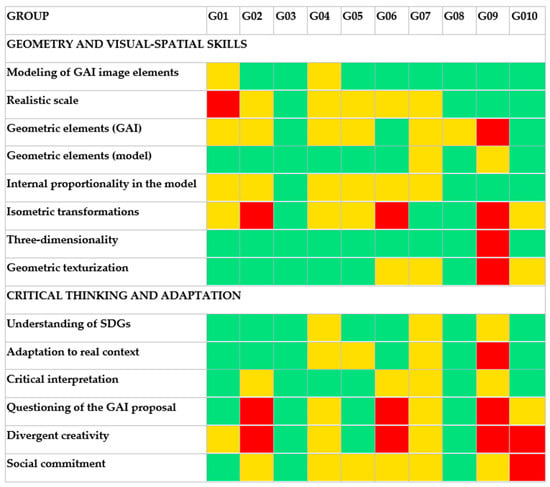
Figure 11.
Comparative Analysis Matrix (green = high, yellow = medium, red = low).
By contrast, in the case of scale, the presence of red alongside several yellows indicated that proportionality to the real context was not consistently maintained, as students did not always achieve correct visual identification or perception of spatial relationships when constructing the model. Comparing the predominance of colours between the geometric elements generated by AI and those represented by students in their models, the greater presence of green in the latter indicated the importance of strengthening spatial literacy in geometry. This also showed how students were able to incorporate more geometric elements into their physical models than the AI included in its design.
Regarding isometric transformations, the diversity of colours indicated that, in some proposals, they were clearly preserved when moving from the AI image to the model, whereas in others they were omitted. This may suggest that the concepts of isometry and the spatial skill of perceptual conservation were not always understood or prioritised in the design process.
Furthermore, the predominance of green in three-dimensional representation confirmed that this transformation was successfully achieved in most cases. This finding was relevant since converting the AI-generated image into a three-dimensional model denoted spatial understanding and geometric visual memory. Concerning geometric textures, the predominance of green, accompanied by some yellows, indicated a generally adequate handling of textures, though with areas for improvement in coherence and level of detail. From a didactic perspective, this may suggest a lack of visual discrimination or visual memory, as students did not always establish a clear connection between the AI image’s digital texturing and the model’s physical texturing. Overall, the data revealed strong performance in the use of elements and proportions, though with variability in the handling of some, highlighting the importance of strengthening spatial literacy and the connection between digital design and mathematical modelling.
On the other hand, regarding critical thinking skills, the predominance of green demonstrated a solid understanding of the Sustainable Development Goals (SDGs) within the proposals, evidencing a link between creative work and the global framework set out by the 2030 Agenda. No significant weaknesses were detected in the adaptation of the proposals to real contexts or in critical interpretation. Regarding critical questioning of AI-generated solutions and divergent creativity, an intermediate level was reached. This may reflect a tension between conceptual ideas and practical feasibility, a firm reliance on the original design, and a need to integrate methodologies that foster divergent thinking and creative variation.
Finally, concerning social engagement, while the social values of the SDGs were acknowledged, their translation into tangible proposals did not consistently achieve complete coherence, as indicated by the predominance of yellow. This revealed a gap between conceptual design and practical feasibility—an aspect that is key to projects aimed at achieving social impact.
The work carried out by Group G01 (Figure 12a), titled “One City, Two Realities: The Challenge of Eradicating Poverty”, demonstrated the assimilation of the geometric property of asymmetry and the skill of visual discrimination to represent two realities—parallel yet opposed—that could coexist within the same urban space where social and economic inequalities may emerge.
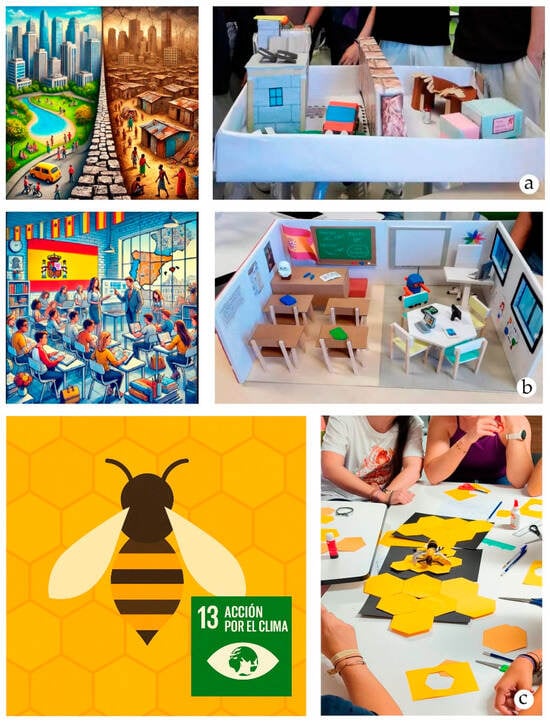
Figure 12.
Comparison between AI-generated images (left) and student-constructed models (right). (a) “One City, Two Realities: The Challenge of Eradicating Poverty”; (b) “Empowering Education for Change”; (c) “Bees as Allies for the Balance of Nature”. Source: Student works.
Equally revealing was the work of Group G03, “Empowering Education for Change” (Figure 12b), which reflected the knowledge acquired in Phase 2 of the workshop (CSL training). Here, students understood that the sociocultural meaning of geometric forms could carry symbolic connotations linked to power hierarchies or democratic equality. Accordingly, they employed the democratic meanings of geometric figures such as the circle and the hexagon to first question the AI-generated image critically and, subsequently, redesign the concept by transgressing the representation of traditional education. This was illustrated in the arrangement of rectangular tables directed toward the teacher in the AI image—reproduced on the left side of the model—in contrast to a hexagonal table on the right side, symbolising innovative education grounded in active teaching–learning methodologies.
The hexagon was once again re-signified by Group G02 in their response to “Climate Action” through the model “Bees as Allies for the Balance of Nature” (Figure 12c). Here, they constructed a honeycomb composed of a hexagonal pattern, in which the union and interconnection of individual forces symbolised sustainability.
6. Discussion and Conclusions
The results obtained allow us to answer the four research questions posed.
In response to the first research question, the findings showed that students demonstrated a varied repertoire of spatial skills (visual identification, perception of spatial relationships, and visual discrimination), with particular prominence of SS2 and SS5 in the analysis of two-dimensional artworks (pre-test), and a more transversal development in terms of the number of spatial skills displayed in the three-dimensional artwork (post-test). These results were consistent with the literature linking geometric practice to the progression of spatial visualisation and the construction of form—meaning relationships (; ; ; ; ). At the same time, critical thinking skills emerged, moving from basic interpretation (CTS1) to emerging inference and evaluation (CTS2–CTS3), with signs of metacognition (CTS4) in the post-test, in line with (), (), and (). The appearance of CTS3 and CTS4 only in the post-test artworks evidenced progress in hermeneutical work. Results indicated that in the pre-test, students tended to make interpretations focused on formal and descriptive aspects, whereas in the post-test, more complex readings emerged, linked to social critique, gender equality, and historical reflection (; ; ; ; ; ). From the onto-semiotic perspective, students connected geometric objects and relationships with sociocultural meanings, showing sensitivity to context and social practices, as proposed by (). The analysis of the selected artworks demonstrates that geometric elements should not be interpreted solely in formal terms, but as carriers of cultural and social meanings that directly contribute to the construction of a critical, egalitarian, and conscious citizenship. Taken together, these findings show that CSL not only enhances spatial literacy but also enables situated critical learning, in line with the integrative perspective of STEAM-H ().
Regarding the second question, spatial skills, critical thinking skills, and onto-semiotic dimensions were articulated simultaneously in the analysis of each artwork, forming a complex network of competencies. In The Last Supper, the identification of symmetries and proportional relationships () was linked with inferences about social and cultural hierarchies, showing the interrelationship between geometric visualisation and meaning-making (; ; ). In The Dinner Party, the exploration of triangular and modular arrangements led not only to spatial descriptions but also to critical interpretations of gender and power, reflecting sensitivity to a feminist perspective and a progression toward higher levels of inference and evaluation (; ). Similarly, in the pair Oath of the Horatii–Standing Figure in Three Modules, the analysis of proportions and three-dimensional volumes was integrated with cultural and symbolic reflection, evidencing how spatial and critical skills converged within an onto-semiotic framework that linked mathematical objects with social practices and meanings (; ). The recurrent relationship between SS2–SS5, CTS1–CTS2, and OSAD2 across all work pointed to the connection between the recognition of geometric figures and concepts, confirming the influence of culturally encoded meanings in interpretation (; ), and revealing a simultaneous coupling between geometric recognition, sociocultural signification, and critical reasoning. Altogether, this analysis highlighted Standing Figure in Three Modules as the artwork with the widest interpretive scope. In this case, the relationship between SS2–SS5 and OSAD5 indicated the predominance of geometric exemplification, with the broadest articulation of categories enabled by its three-dimensional format—consistent with recent evidence on immersive environments and visualisation (). Collectively, these findings demonstrate that competencies do not develop in isolation but in a simultaneous dynamic that reinforces the interdisciplinary nature of the STEAM-H approach (; ).
Regarding the third question, in the training of future critical–visual maker teachers, the modelling and construction of physical models from AI-generated images revealed an intermediate level of geometric spatial skills and a moderate development of critical thinking skills, which may be attributable to their CSL training. The traffic-light analysis evidenced strengths in three-dimensionality and texturing, confirming students’ ability to transfer digital representations into tangible objects (). However, limitations were also observed in realistic scaling and internal proportionality, consistent with studies emphasising the need for greater scaffolding to consolidate spatial visualisation (; ). Regarding critical thinking, students showed progress in interpretation and explanation, but less development in divergent thinking and in questioning AI proposals, indicating that critical evaluation still needs strengthening (; ; ). These findings confirm that CVM Culture, when integrated with GAI and framed within STEAM-H, provides a fertile environment for collaborative learning oriented toward the SDGs, as long as critical and spatial competencies are reinforced from an ethical and social perspective (; ; ; ; ).
Finally, in response to the fourth question, the study confirmed that the interaction among STEAM-H, CVM Culture, and CSL created an integrative ecosystem that enhanced geometric creativity, critical spatial literacy, and interdisciplinarity. CSL situates geometric analysis in sociocultural contexts, transforming the reading of artworks into an exercise of geometric learning, social critique, and citizenship building (; ; ; ; ; ). CVM Culture introduces the practical, collaborative dimension, where creativity materialises in prototypes that connect ideas to real-world problems, fostering reflective processes that strengthen critical spatial literacy (; ; ). These three frameworks, represented as interlocking gears, do not operate in isolation but drive each other, generating a cycle of interdisciplinary, creative, and critical learning. This ecosystem links geometry and art history with issues of gender, power, and sustainability, in line with the goals of the 2030 Agenda (; ; ; ).
The STEAM-H–CVM–CSL triad, as a pathway to foster mathematical, social, and cultural transformation from the classroom, provides a coherent environment to develop visuospatial competencies and critical thinking applied to geometric visual culture and the SDGs. Within this process, students progress from formal descriptions toward inference, evaluation, and metacognition, making explicit connections between geometric objects and sociocultural meanings, as future teachers learn to read the images of the world, to recognise the traces of power, inequality, and resistance, and to imagine possible alternatives. In conclusion, the study demonstrates that articulating art history, geometry, and critical thinking within the STEAM-H framework constitutes an innovative and practical pathway for preparing citizens committed to building sustainable futures.
Author Contributions
Conceptualization, E.-I.C.-G. and S.-N.M.-S.; Data curation, E.-I.C.-G. and S.-N.M.-S.; Formal analysis, E.-I.C.-G. and S.-N.M.-S.; Funding acquisition, E.-I.C.-G. and S.-N.M.-S.; Investigation, E.-I.C.-G. and S.-N.M.-S.; Methodology, E.-I.C.-G. and S.-N.M.-S.; Project administration, E.-I.C.-G. and S.-N.M.-S.; Resources, E.-I.C.-G. and S.-N.M.-S.; Supervision, E.-I.C.-G. and S.-N.M.-S.; Validation, E.-I.C.-G. and S.-N.M.-S.; Visualisation, E.-I.C.-G. and S.-N.M.-S.; Writing—original draft, E.-I.C.-G. and S.-N.M.-S.; Writing—review and editing, E.-I.C.-G. and S.-N.M.-S. All authors have read and agreed to the published version of the manuscript.
Funding
This research was supported by the following research projects: «Alfabetización multimodal y artivismo didáctico museístico para la formación de una generación de docentes “Woke”» [“Multimodal Literacy and Museum Artivism for the Training of a Generation of ‘Woke’ Teachers”] (B1-2022_06, University of Malaga); «La evaluación de los aprendizajes universitarios con tecnologías emergentes: beneficios y riesgos de la Inteligencia Artificial (EVALIATE)» [“The Evaluation of University Learning with Emerging Technologies: Benefits and Risks of Artificial Intelligence (EVALIATE)”] (D5-2023_02, University of Malaga); and PID2022-141325NB-I00 (MICIU/AEI/10.13039/50110001/FEDER.UE).
Institutional Review Board Statement
The study was conducted in accordance with the Declaration of Helsinki, and approved by the Ethics Committee of University of Málaga (protocol code 134-2024-H, with approval granted on 4 September 2024).
Informed Consent Statement
Informed consent was obtained from all subjects involved in the study.
Data Availability Statement
Data is contained within the article.
Conflicts of Interest
The authors declare no conflicts of interest.
Abbreviations
The following abbreviations are used in this manuscript:
| STEAM-H | Science, Technology, Engineering, Arts, Mathematics, and Humanities |
| CVM | Critical-Visual Maker |
| CSL | Critical Spatial Literacy |
| ESD | Education for Sustainable Development |
| SDG | Sustainable Development Goals |
| SS | Spatial Skills |
| OSAD | Onto-Semiotic Dimension |
| CTS | Critical Thinking Skills |
References
- Acaso, M., & Megías, C. (2017). Art thinking. Ediciones Paidós. [Google Scholar]
- Agbedahin, A. V. (2019). Sustainable development, education for sustainable development, and the 2030 agenda for sustainable development: Emergence, efficacy, eminence, and future. Sustainable Development, 27(4), 669–680. [Google Scholar] [CrossRef]
- Aguirre-Aguilar, G. (2024). Entornos personales de aprendizaje. In L. Navarro, J. A. Hidalgo, & G. Guillén (Eds.), Inteligencia artificial y comunicación (pp. 103–127). Zenodo. [Google Scholar] [CrossRef]
- Albornoz-Acosta, J. A., Maldonado-Cid, J. G., Vidal-Silva, C. L., & Madariaga, E. (2020). Impacto y recomendaciones de clase invertida en el proceso de enseñanza-aprendizaje de geometría. Formación Universitaria, 13(3), 3–10. [Google Scholar] [CrossRef]
- Alsina, Á., Contreras, M., & Reyes, J. (2022). Matemáticas en contexto en Educación Primaria: Conexiones con el entorno y la música. Unión-Revista Iberoamericana de Educación Matemática, 18(64), 1–20. [Google Scholar]
- Al-Thani, N. J., & Ahmad, Z. (2025). Teaching and learning with research cognitive theory: Unlocking curiosity and creativity for problem-solving skills. Springer Nature. [Google Scholar] [CrossRef]
- Alvén, F. (2024). Controversial issues in history teaching. Journal of Curriculum Studies, 56(5), 537–553. [Google Scholar] [CrossRef]
- Amador, J. (2015). Notas acerca de una hermenéutica de la imagen. Revista Mexicana de Ciencias Políticas y Sociales, 40(161), 9–29. [Google Scholar] [CrossRef]
- Aparicio-Gómez, O. Y., Ostos-Ortiz, O. L., & Von Feigenblatt, O. F. (2023). Competencia digital y desarrollo humano en la era de la Inteligencia Artificial. Hallazgos, 20(40), 217–235. [Google Scholar] [CrossRef]
- Arnheim, R. (1974). Art and visual perception: A psychology of the creative eye. University of California Press. [Google Scholar]
- Balyk, N. R., Vasylenko, Y. P., Shmyger, G. P., Oleksiuk, V. P., & Balyk, A. V. (2025). STEAM+ H: A model for integrating humanities and sustainable development in the STEAM educational paradigm. CEUR Workshop Proceedings, 3949, 72–92. [Google Scholar]
- Banks, F., & Barlex, D. (2020). Teaching STEM in the secondary school: Helping teachers meet the challenge. Routledge. [Google Scholar]
- Barromi-Perlman, E., Dekel, T., & Barchana-Lorand, D. (2021). Gender and visual literacy: Towards gender-sensitive readings. Journal of Visual Literacy, 40(3–4), 145–148. [Google Scholar] [CrossRef]
- Barton, K. C., & Ho, L. C. (2021). Curriculum for justice and harmony: Deliberation, knowledge, and action in social and civic education. Routledge. [Google Scholar]
- Basilotta-Gómez-Pablos, V., Matarranz, M., Casado-Aranda, L.-A., & Otto, A. (2022). Teachers’ digital competencies in higher education: A systematic literature review. International Journal of Educational Technology in Higher Education, 19, 8. [Google Scholar] [CrossRef]
- Brookfield, S. (2020). Teaching for critical thinking. International Journal of Adult Education and Technology (IJAET), 11(3), 1–21. [Google Scholar] [CrossRef]
- Bruning, R. H., Schraw, G. J., & Ronning, R. R. (2012). Psicología cognitiva e instrucción. Alianza. [Google Scholar]
- Cagua Gomez, B. (2022). La maqueta como recurso didáctico para la enseñanza de matemática en arquitectura. INGENIO, 5(2), 24–30. [Google Scholar] [CrossRef]
- Castañeda, L., & Villar-Onrubia, D. (2023). Beyond functionality: Building critical digital teaching competence among future primary education teachers. Contemporary Educational Technology, 15(1), ep397. [Google Scholar] [CrossRef] [PubMed]
- Chung, S. K. (2013). Critical visual literacy. The International Journal of Arts Education, 11, 1–36. [Google Scholar]
- Clapp, E. P., Ross, J., Ryan, J. O., & Tishman, S. (2017). Maker-centered learning: Empowering young people to shape their worlds. John Wiley & Sons. [Google Scholar]
- Del Grande, J. J. (1990). Spatial sense. Arithmetic Teacher, 37(6), 14–20. [Google Scholar] [CrossRef]
- Duncum, P. (2010). Seven principles for visual culture education. Art Education, 63(1), 6–10. [Google Scholar] [CrossRef]
- Dutta, K. (2024). Art in sacred geometry: A new perspective for multidisciplinary STEAM education. Journal of Mathematics and the Arts, 18(1–2), 66–100. [Google Scholar] [CrossRef]
- Eisner, E. (2003). The arts and the creation of mind. Language Arts, 80(5), 340–344. [Google Scholar] [CrossRef]
- El Bedewy, S., Lavicza, Z., & Lyublinskaya, I. (2024). STEAM practices connecting mathematics, arts, architecture, culture and history in a non-formal learning environment of a museum. Journal of Mathematics and the Arts, 18(1–2), 101–134. [Google Scholar] [CrossRef]
- Elder, L., & Paul, R. (2020). Critical thinking: Tools for taking charge of your learning and your life. Rowman & Littlefield. [Google Scholar]
- Elvas Fernández, M. I., & Ramírez Uclés, R. (2025). Análisis del sentido espacial en estudiantes de secundaria en actividades PISA. Avances De Investigación En Educación Matemática, (27), 203–221. [Google Scholar] [CrossRef]
- Facione, P. (1990). Critical thinking: A statement of expert consensus for purposes of educational assessment and instruction (the Delphi report). The California Academic Press. [Google Scholar]
- Falkenhausen, S. V. (2020). Beyond the mirror: Seeing in art history and visual culture studies. Transcript Verlag. [Google Scholar]
- Fernández Galán, C., & García Ramírez, J. (2013). Lectura de la imagen: ¿semiótica o hermenéutica? Imaginario Visual, 2(4), 48–55. Available online: http://eprints.uanl.mx/3387/ (accessed on 1 May 2025).
- Floridi, L. (2019). The logic of information: A theory of philosophy as conceptual design. Oxford University Press. [Google Scholar]
- Fowler, S., Cutting, C., Kennedy, J., Leonard, S. N., Gabriel, F., & Jaeschke, W. (2022). Technology enhanced learning environments and the potential for enhancing spatial reasoning: A mixed methods study. Mathematics Education Research Journal, 34(4), 887–910. [Google Scholar] [CrossRef]
- Freedman, K. (2025). Teaching visual culture: Curriculum, aesthetics, and the social life of art. Teachers College Press. [Google Scholar]
- Gabowitsch, M., & Topolska, A. (2023). Visual literacy in history education: Textbooks and beyond. Journal of Educational Media, Memory, and Society, 15(1), 1–19. [Google Scholar] [CrossRef]
- García-Fuentes, O., Raposo-Rivas, M., & Martínez-Figueira, M. E. (2023). El enfoque educativo STEAM: Una revisión de la literatura. Revista Complutense de Educación, 34(1), 191–202. [Google Scholar] [CrossRef]
- Gardner, H. (1995). Reflections on multiple intelligences: Myths and messages. Phi Delta Kappan, 77, 200–211. [Google Scholar]
- Giroux, H. A. (2020). On critical pedagogy. Bloomsbury Publishing. [Google Scholar]
- Godino, J. D. (2024). Enfoque ontosemiótico en educación matemática: Fundamentos, herramientas y aplicaciones. Aula Magna Proyecto clave McGraw Hill. [Google Scholar]
- Godino, J. D., Batanero, C., & Font, V. (2020). El enfoque ontosemiótico: Implicaciones sobre el carácter prescriptivo de la didáctica. Revista Chilena de Educación Matemática, 12(2), 47–59. [Google Scholar] [CrossRef]
- Guillén, G. (2000). Sobre el aprendizaje de conceptos geométricos relativos a los sólidos: Ideas erróneas. Enseñanza de las Ciencias, 18(1), 35–53. [Google Scholar] [CrossRef]
- Gutiérrez, Á., & Jaime, A. (2021). Desafíos actuales para la didáctica de las matemáticas. Revista Innovaciones Educativas, 23(34), 198–203. [Google Scholar] [CrossRef]
- Han, J., Kelley, T. R., Mentzer, N., & Knowles, J. G. (2021). Community of practice in integrated STEM education: A systematic literature review. Journal of STEM Teacher Education, 56(2), 5. [Google Scholar] [CrossRef]
- He, Y. (2019). Traffic light cards: A cross and modification between the minute paper and Muddiest Point. College Teaching, 67(1), 70–72. [Google Scholar] [CrossRef]
- Hernández, R., Fernández, C., & Baptista, P. (2014). Metodología de la investigación. McGrawHill. [Google Scholar]
- Housen, A. (2002). Aesthetic thought, critical thinking and transfer. Arts and Learning Research Journal, 18(1), 99–132. [Google Scholar]
- Jewitt, C., & Kress, G. (Eds.). (2003). Multimodal literacy. Peter Lang. [Google Scholar]
- Knox, J. (2020). Artificial intelligence and education in China. Learning, Media and Technology, 45(3), 298–311. [Google Scholar] [CrossRef]
- Kopnina, H. (2018). Education for sustainable development (ESD): The turn away from ‘environment’ in environmental education? In Environmental and sustainability education policy (pp. 135–153). Routledge. [Google Scholar]
- Kress, G., & Bezemer, J. (2023). Multimodal discourse analysis. In The Routledge handbook of discourse analysis (pp. 139–155). Routledge. [Google Scholar]
- Kyeong-Hwa, L., Yeo, S., Byungjoo, T., Choi, J., Taekwon, S., & Jihyun, O. (2023). A study on the factors of elementary school teachers’ intentions to use AI math learning system: Focusing on the case of TocToc-Math. The Mathematical Education, 63(2), 35–350. [Google Scholar] [CrossRef]
- Lam-Byrne, A. G. (2023). El aprendizaje STEAM: Una práctica inclusiva. Revista Científica Episteme y Tekne, 2(1), e466. [Google Scholar] [CrossRef]
- Lavicza, Z., Abar, C. A. P., & Tejera, M. (2023). Spatial geometric thinking and its articulation with the visualization and manipulation of objects in 3D. Educação Matemática Pesquisa Revista do Programa de Estudos Pós-Graduados em Educação Matemática, 25(2), 258–277. [Google Scholar] [CrossRef]
- Legardez, A. (2017). Propositions pour une modélisation des processsus de didactisation sur des questions socialement vives. Sisyphus—Journal of Education, 5(2), 79–99. [Google Scholar] [CrossRef]
- Levratto, V., Gómez Gómez, H., & Ramé López, J. (2024). Implementing visual literacy techniques among future educators in pre-school and primary school settings. Journal of Visual Literacy, 43(4), 326–343. [Google Scholar] [CrossRef]
- Lévesque, S., & Croteau, J. P. (2020). Beyond history for historical consciousness: Students, narrative, and memory. University of Toronto Press. [Google Scholar]
- Marcone, G. (2022). Humanities and social sciences in relation to sustainable development goals and STEM education. Sustainability, 14(6), 3279. [Google Scholar] [CrossRef]
- Marques, D., Neto, T. B., Guerra, C., Viseu, F., Aires, A. P., Mota, M., & Ravara, A. (2023). A STEAM experience in the mathematics classroom: The role of a science cartoon. Education Sciences, 13(4), 392. [Google Scholar] [CrossRef]
- Martínez Bravo, M. C., Sádaba Chalezquer, C., & Serrano-Puche, J. (2021). Meta-marco de la alfabetización digital: Análisis comparado de marcos de competencias del Siglo XXI. Revista Latina de Comunicación Social, 79, 76–110. [Google Scholar] [CrossRef]
- McCormack, J., Gifford, T., & Hutchings, P. (2019). Autonomy, authenticity, creativity and intention in computer generated art. In International conference on computational intelligence in music, sound, art and design (part of EvoStar) (pp. 35–50). Springer International Publishing. [Google Scholar]
- Mirzoeff, N. (2015). How to see the world. Penguin Books Limited. [Google Scholar]
- Mitchell, W. J. (2002). Showing seeing: A critique of visual culture. Journal of Visual Culture, 1(2), 165–181. [Google Scholar] [CrossRef]
- Mitchell, W. J. (2024). Iconology: Image, text, ideology. University of Chicago Press. [Google Scholar]
- Montés, N., Barquero, S., Martínez-Carbonell, A., Aloy, P., Ferrer, T., Romero, P. D., Millan, M., & Salazar, A. d. S. (2024). Redefining STEAM to STEAM ∀H (STEAM for all humanity) in higher education. Education Sciences, 14(8), 888. [Google Scholar] [CrossRef]
- Montiel, M., Wilhelmi, M. R., & Mannone, M. (2024). Assessment of mathematical learning in a musical composition workshop applying tools from the onto-semiotic approach. Bolema: Boletim de Educação Matemática, 38, e220021. [Google Scholar] [CrossRef]
- Moral-Sánchez, S. N., Sánchez Compaña, M. T., & Romero Albaladejo, I. (2023). Uso de realidad virtual en Geometría para el desarrollo de habilidades espaciales (Volume 41, 1, pp. 125–147). Revista de Investigación y Experiencias Didácticas; Enseñanza de las Ciencias. [Google Scholar] [CrossRef]
- Namukasa, I. K., Hughes, J., & Scucuglia, R. (2021). STEAM and critical making in teacher education. In M. Danesi (Ed.), Handbook of cognitive mathematics. Springer. [Google Scholar] [CrossRef]
- Nurhikmayati, I., Kusumah, Y. S., & Darhim, D. (2024). Mathematical critical thinking skills through STEM/STEAM approach: A systematic literature review. The Eurasia Proceedings of Educational and Social Sciences, 35, 145–160. [Google Scholar] [CrossRef]
- Nussbaum, M. (2010). Not for profit: Why democracy needs the humanities. Princeton University Press. [Google Scholar]
- Palao Andrés, J. M., & Hernández Hernández, E. (2012). Validation of an instrument to assess student learning perception and level of enjoyment in physical education: The traffic light. Cuadernos de Psicología del Deporte, 12(1), 25–32. [Google Scholar] [CrossRef]
- Peppler, K., Halverson, E. R., & Kafai, Y. B. (2019). Makeology: Makerspaces as learning environments. Routledge. [Google Scholar]
- Presmeg, N., Radford, L., Roth, W. M., & Kadunz, G. (2016). Semiotics in mathematics education. Springer Nature. [Google Scholar]
- Ramírez-Uclés, I., & Ramírez Uclés, R. (2023). Gender differences in mental rotation test: A geometry-teaching perspective. Educación XX1, 26(2), 351–372. [Google Scholar] [CrossRef]
- Reisman, A., & Jay, L. P. (2024). Coaching teachers in document-based history instruction: Practices that support teacher facilitation of student discourse. Journal of Teacher Education, 75(3), 305–320. [Google Scholar] [CrossRef]
- Revelo Manosalvas, S. L., & Yánez Ronquillo, N. D. P. (2023). Material concreto y su importancia en el fortalecimiento de la matemática: Una revisión documental. MENTOR Revista de investigación Educativa y Deportiva, 2(4), 69–87. [Google Scholar] [CrossRef]
- Rivero Gracia, P., Aso Morán, B., & García-Ceballos, S. (2023). Progresión del pensamiento histórico en estudiantes de secundaria: Fuentes y pensamiento crítico. Revista Electrónica de Investigación Educativa, 25. [Google Scholar] [CrossRef]
- Roehrig, G. H., Dare, E. A., Ellis, J. A., & Ring-Whalen, E. (2021). Beyond the basics: A detailed conceptual framework of integrated STEM. Disciplinary and Interdisciplinary Science Education Research, 3(1), 11. [Google Scholar] [CrossRef]
- Rolling, J. H. (2020). Reinventing the STEAM engine for art + design education. Art Education, 73(5), 8–15. [Google Scholar] [CrossRef]
- Rose, G. (2022). Visual methodologies: An introduction to researching with visual materials. SAGE Publications. [Google Scholar]
- Rüsen, J. (2004). Historical consciousness: Narrative structure, moral function, and ontogenetic development. In P. Seixas (Ed.), Theorizing historical consciousness (pp. 63–85). University of Toronto Press. [Google Scholar]
- Salgado, M., Alsina, Á., & Filgueira, S. (2020). Argumentación matemática a través de actividades STEAM en educación infantil. Épsilon, 104, 45–57. [Google Scholar]
- Santisteban, A. (2019). La enseñanza de las Ciencias Sociales a partir de problemas sociales o temas controvertidos: Estado de la cuestión y resultados de una investigación. El Futuro del Pasado, 10, 57–79. [Google Scholar] [CrossRef]
- Santisteban, A., & Castellví, J. (2021). La formación del pensamiento histórico como pensamiento crítico. In A. Santisteban, & C. A. Lima (Eds.), La Enseñanza de la Historia en Brasil y España: Un Homenaje a Joan Pagès Blanch (pp. 47–68). Editora Fi. [Google Scholar]
- Sanz-Camarero, R., Ortiz-Revilla, J., & Greca, I. M. (2023). The impact of integrated STEAM education on arts education: A systematic review. Education Sciences, 13(11), 1139. [Google Scholar] [CrossRef]
- Schad, M., & Jones, W. M. (2020). The maker movement and education: A systematic review of the literature. Journal of Research on Technology in Education, 52(1), 65–78. [Google Scholar] [CrossRef]
- Seixas, P., & Morton, T. (2013). The big six historical thinking concepts. Nelson Education. [Google Scholar]
- Sinclair, N., & Bruce, C. D. (2015). New opportunities in geometry education at the primary school. ZDM, 47(3), 319–329. [Google Scholar] [CrossRef]
- Statton, D., Beene, S., Greer, K., Wegmann, M., Fullmer, M., Murphy, M., Schumacher, S., & Saulter, T. (2022). A proliferation of images: Trends, obstacles, and opportunities for visual literacy. Journal of Visual Literacy, 41(2), 113–131. [Google Scholar] [CrossRef]
- Sua, C., Gutiérrez, A., & Jaime, A. (2021). Análisis de una actividad de visualización en un entorno de geometría dinámica 3D y realidad aumentada: Alineando puntos en el espacio. In Investigación en Educación Matemática XXIV (pp. 579–586). Sociedad Española de Investigación en Educación Matemática, SEIEM. [Google Scholar]
- Szczygielski, K., & Mycielski, J. (2024). The mutual reinforcement of scientific and technological knowledge—A technology-level analysis. Scientometrics, 129(11), 6533–6549. [Google Scholar] [CrossRef]
- Tan, S., & Sinclair, N. (2025). The aesthetic challenges of doing visual. New directions for mathematics education research on proving: Honoring the legacy of john and Annie Selden. Springer. [Google Scholar]
- Torres-Rivera, A. D., Rendón Peña, A. A., Díaz-Torres, S. T., & Díaz-Torres, L. A. (2025). Ethical integration of AI and STEAM pedagogies in higher education: A sustainable learning model for society 5.0. Sustainability, 17(19), 8525. [Google Scholar] [CrossRef]
- Tsiouri, E. (2025). Teaching geometry and painting: A path to integrating art and mathematics. European Journal of Education Studies, 12(4), 20–42. [Google Scholar] [CrossRef]
- VanSledright, B. A. (2011). The challenge of rethinking history education: On practices, theories, and policy. Routledge. [Google Scholar]
- Wang, T., & Cheng, E. C. K. (2021). An investigation of barriers to Hong Kong K-12 schools incorporating artificial intelligence in education. Computers and Education: Artificial Intelligence, 2, 100031. [Google Scholar] [CrossRef]
- Washington, J., & Walkington, C. (2024). Equitable mathematics instruction and learning geometry through extended reality. Journal of Mathematics Education, 17(1), 52–67. [Google Scholar] [CrossRef]
- Wilks, Y. (2019). Artificial intelligence: Modern magic or dangerous future. Icon. [Google Scholar]
- Yenawine, P. (2013). Visual thinking strategies: Using art to deepen learning across school disciplines. Harvard Education Press. [Google Scholar]
- Zhang, C., & Jia, B. (2024). Enriching STEAM education with visual art: Education benefits, teaching examples, and trends. Discover Education, 3, 247. [Google Scholar] [CrossRef]
Disclaimer/Publisher’s Note: The statements, opinions and data contained in all publications are solely those of the individual author(s) and contributor(s) and not of MDPI and/or the editor(s). MDPI and/or the editor(s) disclaim responsibility for any injury to people or property resulting from any ideas, methods, instructions or products referred to in the content. |
© 2025 by the authors. Licensee MDPI, Basel, Switzerland. This article is an open access article distributed under the terms and conditions of the Creative Commons Attribution (CC BY) license (https://creativecommons.org/licenses/by/4.0/).